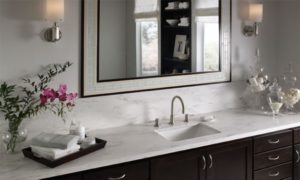 Do you have a solid surface sink which has seen better days? Something that looked spectacular when it was first installed, but over the years, has become dull and tarnished? Have no fears – often, all a solid surface sink needs is a solid cleaning and some restoration work, rather than replacing the entire unit. With a little elbow grease and a little know-how, you can get your sink looking great once again.
Do you have a solid surface sink which has seen better days? Something that looked spectacular when it was first installed, but over the years, has become dull and tarnished? Have no fears – often, all a solid surface sink needs is a solid cleaning and some restoration work, rather than replacing the entire unit. With a little elbow grease and a little know-how, you can get your sink looking great once again.
One of the benefits of solid surface is that it’s a non-porous surface, meaning that stains won’t penetrate deep into your sink or countertops. However, regular abrasion from dishes, pots and pans can still occur, which can cause that smooth luster to dull and fade. Thin, built-up layers of grime and gunk can also adhere to the roughened surface, further dulling its look. Some simple maintenance, however, can get it back to looking spic and span once again.
Tools
For a basic restoration, you’ll want to gather some simple tools before you begin:
- An abrasive cleaner with bleach, such as Comet.
- A scrubbing sponge
- An abrasive pad, if you’re in need of especially deep cleaning
- A small plastic bristled brush
Cleaning Powder
After wetting the sink, take your cleaning powder and spread it liberally all over your sink basins. You’ll want to leave it on the surface for a couple of hours. That allows the bleach to have time to act on that caked-on food gunk, breaking it down and making it easier to clean.
After those few hours, you’ll want to scrub the sink down with the scrubbing sponge. It’s a good idea to wear gloves during this part of the restoration; the chemicals involved aren’t necessarily dangerous, per se, but they really do a number on exposed skin. For tighter areas around seams and drains, the scrub brush will probably be easier to use, and will help remove any residual staining.
Deep Scratch Repair
If you have any very deep scratches, simply using the cleaning powder will not be sufficient to restoring your sink. At this point, you’ll want to break out the sandpaper.
One of the benefits of solid surface is that the pattern and color goes all the way through the countertop—it’s not just on the surface layer. Therefore, many scratches can actually be sanded out without damaging the look of your sink.
Start with a 400-grit piece of sandpaper, and see if that works. If the scratch remains, continue with more aggressive grits, even down to 60-grit.
The Toughest Scratches
If you’re an expert DYIer, you can handle even deeper scratches than that, though that’s a much more complicated process than simple cleaning and sanding. An old rotary tool, equipped with an aluminum oxide bit, can be used to polish out deep scratches. A diamond cutting wheel can be used to cut a deep groove right on the dark marks, which will remove the scratches but will require them to be filled back in again, using epoxy.
Final Steps
Once you’ve restored your sink, be it with cleansers, sandpaper or epoxy, it should look good as new again. You can keep it looking newer for longer by regularly cleaning it with an abrasive cleaner and pad – it’s much easier to stay on top of cleaning regularly rather than making a major project out of it every few years.
Our trained professionals here can help you if you don’t feel confident dealing with the deepest scratches. If you want the benefit of experienced contractors with years of experience, or simply need some more personalized advice on how to continue, please don’t hesitate to contact us. We’re glad to help with the fabrication, installation and maintenance of solid surface material, and we promise to bring the absolute best experience to each and every one of our clients.
 Installing solid-surface countertops yourself can be a challenging task for even the most avid DYIer. This is why so many professional services exist – to help navigate all the challenges and issues the layman is likely to encounter when trying to get a professional, long-lasting look in their countertops.
Installing solid-surface countertops yourself can be a challenging task for even the most avid DYIer. This is why so many professional services exist – to help navigate all the challenges and issues the layman is likely to encounter when trying to get a professional, long-lasting look in their countertops.



 Copyright © 2024 · Solid Surface · Web design by
Copyright © 2024 · Solid Surface · Web design by